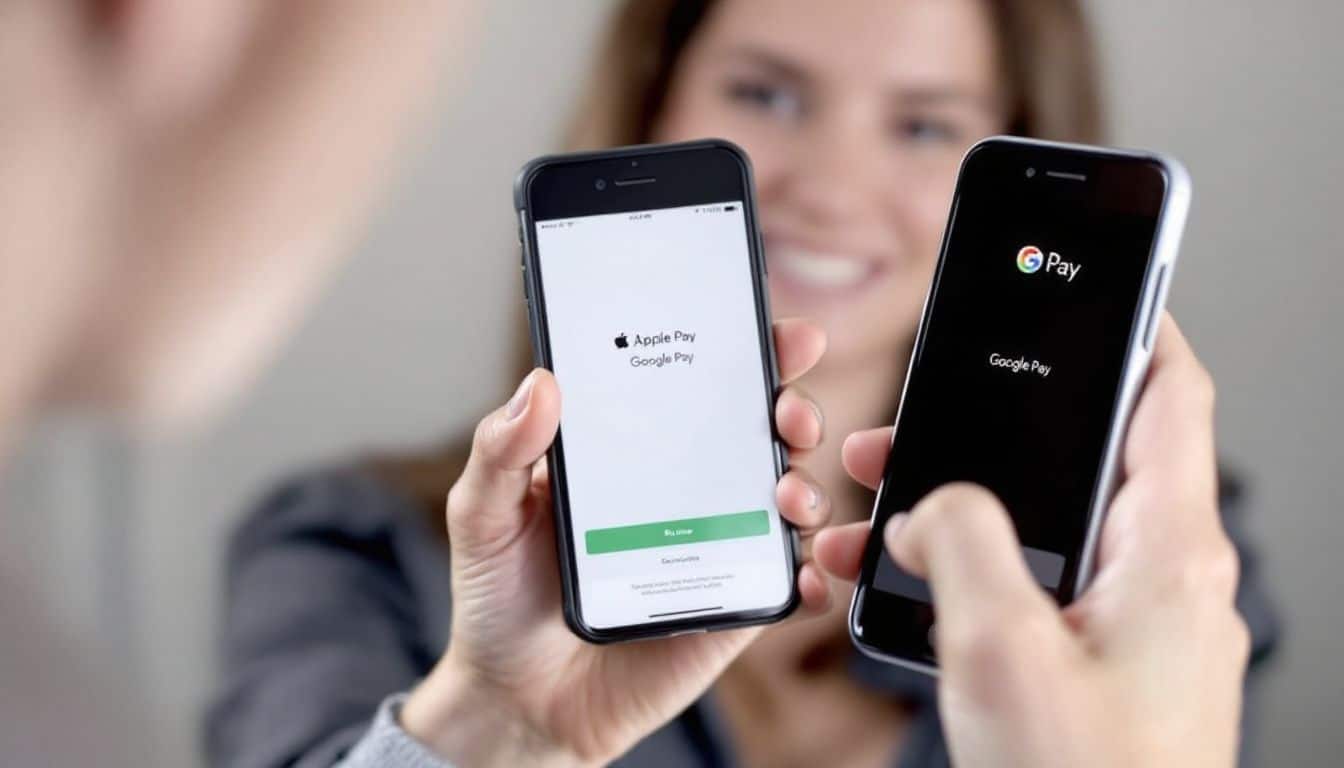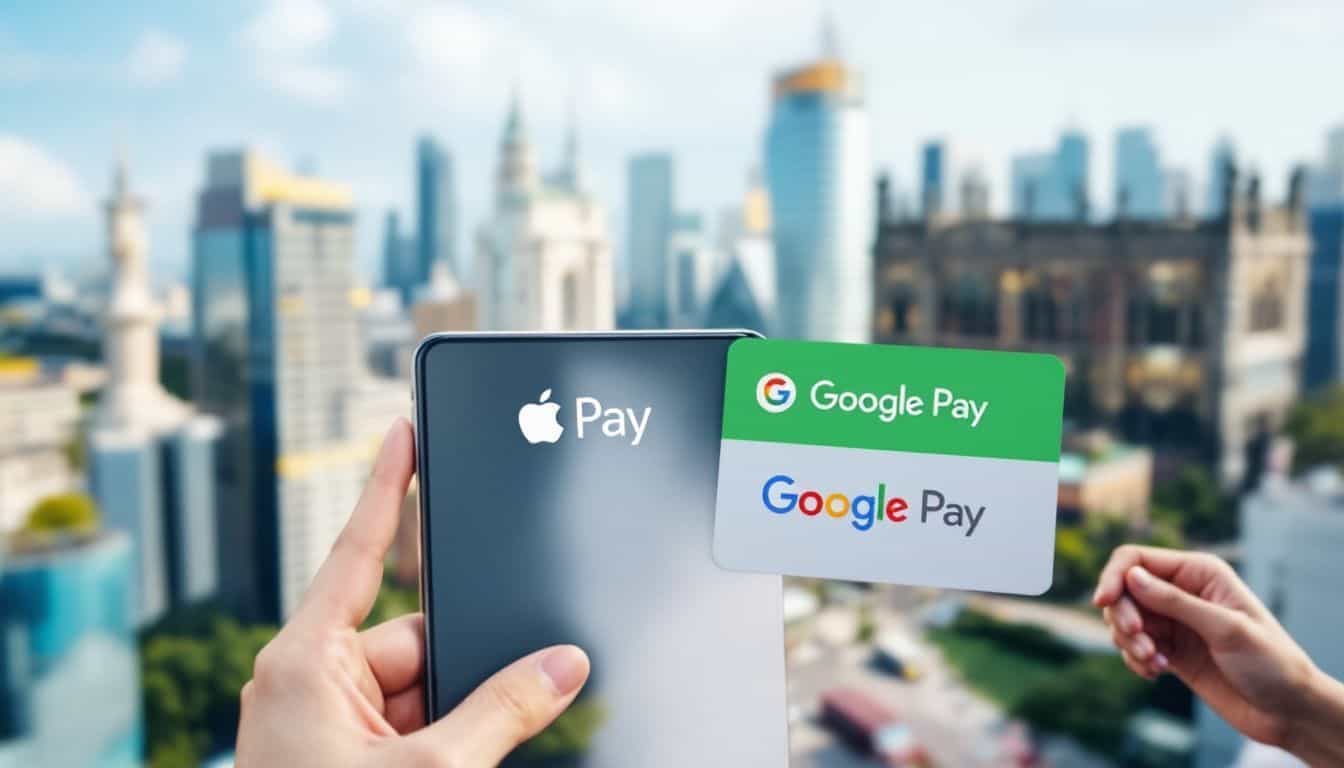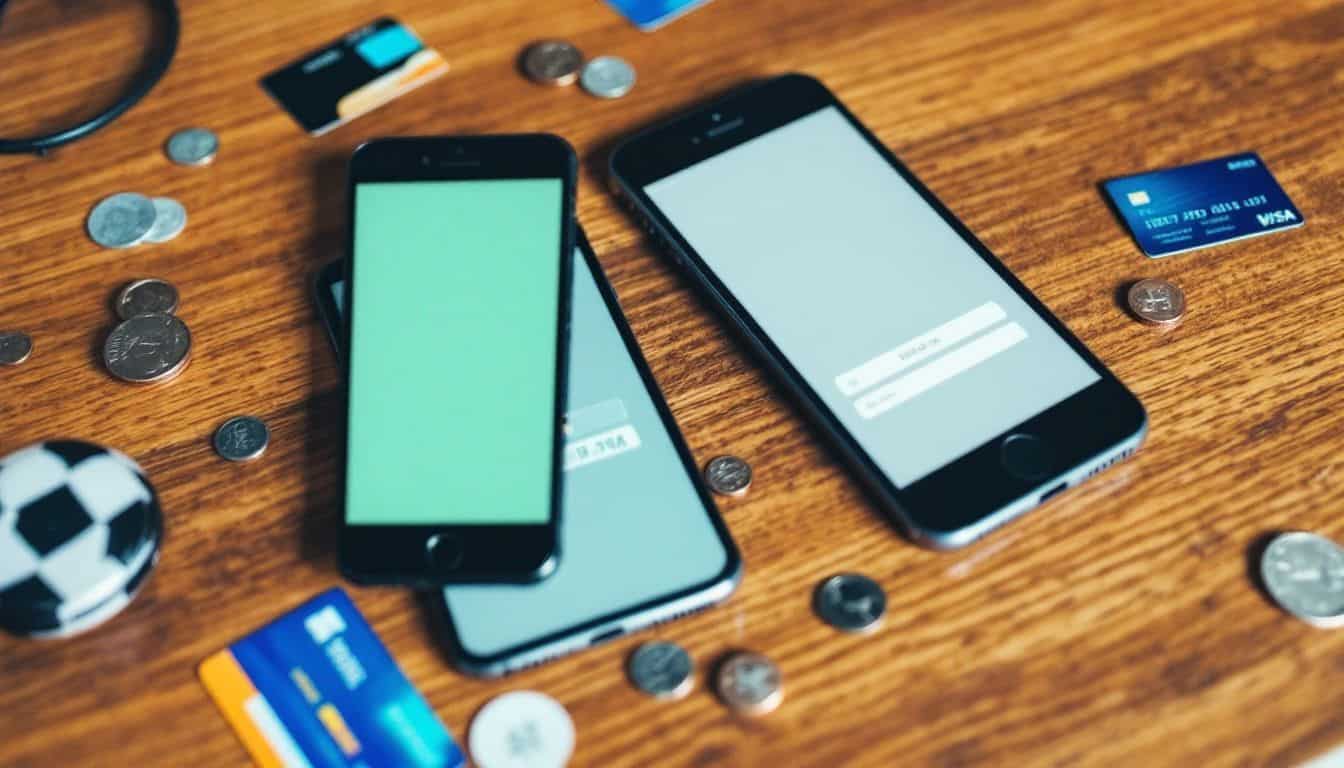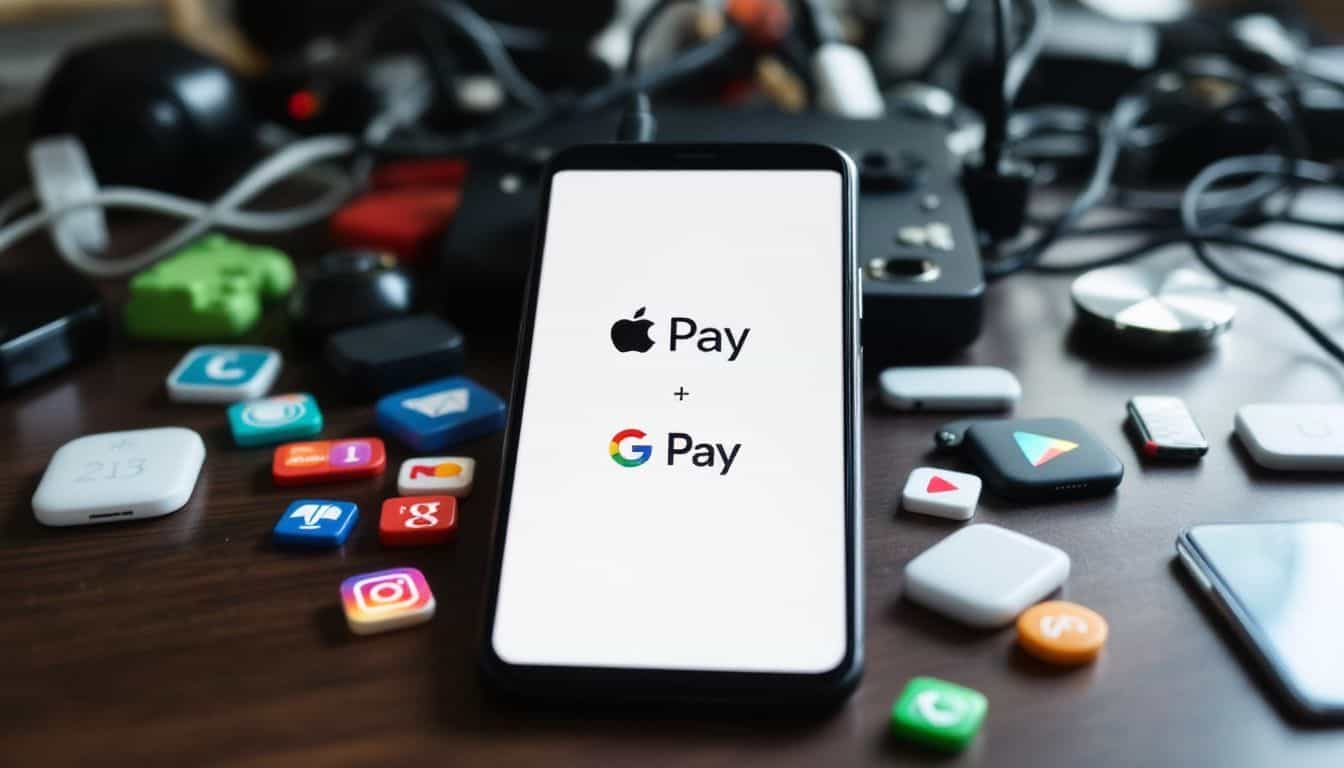Are you confused about which digital wallet to use? Apple Pay and Google Pay are two big names in mobile payments. These apps let you pay with your phone instead of cash or cards. This blog will compare Apple Pay and Google Pay to help you choose.
Ready to find your perfect digital wallet?
Key Takeaways
Apple Pay works only on Apple devices, while Google Pay is compatible with both Android and iOS.
Apple Pay uses Face ID or Touch ID for security, while Google Pay relies on a PIN.
Apple Pay leads with 60.2 million U.S. users and 48% of digital wallet transactions, compared to Google Pay’s 25.2 million users and 10.3% of transactions.
Both services use tokenization and encryption to protect user data, but Apple claims not to track transactions while Google stores card details on its servers.
Apple Pay offers its own credit card and payment plans, while Google Pay focuses solely on being a digital wallet without lending options.
Table of Contents
Key Features of Apple Pay and Google Pay

Let’s dive into the nitty-gritty of Apple Pay and Google Pay. These digital wallets pack a punch with features that’ll make your head spin – in a good way!
Device Compatibility and Access

Apple Pay and Google Pay play nice with different gadgets. Apple Pay sticks to its own family – iPhones, iPads, and Apple Watches. It’s like a VIP club for Apple fans. Google Pay, on the other hand, is more of a social butterfly.
It works on both Android and iOS devices, making it a hit at any tech party.
But here’s the kicker – Apple Pay needs Face ID or Touch ID to work its magic. Google Pay? It’s cool with a simple PIN. This means Google Pay can work on more devices, even older ones.
Apple Pay is the cool kid who only hangs out with other Apple kids. Google Pay? It’s the friendly neighbor who gets along with everyone.
It’s like the difference between a fancy key card and a good old-fashioned key – both get you in, but one’s a bit more high-tech.
Security Protocols and User Safety

Moving from device access to safety, let’s talk about how these digital wallets keep your money secure. Both Apple Pay and Google Pay use top-notch security measures to protect your cash.
Apple Pay uses a cool trick called tokenization. It swaps your real card number with a fake one – the Device Account Number. This DAN is what stores and payment systems see, not your actual card info.
Pretty slick, right? Google Pay does something similar. It keeps your card details locked away and gives out a virtual card for each purchase. Both systems also use fancy encryption to keep your data safe from prying eyes.
And here’s a neat touch: Apple lets you use your fingerprint with Touch ID, while Google asks for a PIN. It’s like having a tiny Fort Knox in your pocket!
Comparing Transaction Speeds

Speed matters in digital payments. Apple Pay and Google Pay both aim to make transactions quick and easy. But how do they stack up? Let’s break it down:
| Feature | Apple Pay | Google Pay |
|---|---|---|
| NFC Speed | Lightning fast (?1-2 seconds) | Super quick (?2-3 seconds) |
| In-app Purchases | Seamless (?3-5 seconds) | Smooth (?4-6 seconds) |
| Online Checkouts | Swift (?10-15 seconds) | Rapid (?12-18 seconds) |
| Peer-to-Peer Transfers | Quick (?1-2 minutes) | Fast (?1-3 minutes) |
Apple Pay edges out Google Pay by a hair in most cases. But let’s be real – we’re talking seconds here. Both are way faster than fumbling for cash or swiping a card. The real game-changer? How these digital wallets handle security…
Analyzing User Experience with Apple Pay and Google Pay

Let’s dive into the user experience of Apple Pay and Google Pay. Both apps aim to make your life easier, but they’ve got their own unique flavors – kinda like choosing between a crisp apple or a juicy orange.
Interface Design and Usability

Apple Pay and Google Pay both shine in their user-friendly designs. Apple Pay’s interface is sleek and simple, perfect for iOS fans. It uses Touch ID, making payments a breeze. Just place your finger on the home button, and you’re good to go! Google Pay, on the other hand, works on both iOS and Android.
It’s clean and easy to navigate, with a PIN for security. I’ve used both, and they’re equally smooth in daily use.
The real magic happens when you tap to pay. Both apps show your card info and amount due clearly. Apple Pay’s animation of your card is pretty cool. Google Pay keeps it simple with a big “G” logo.
No matter which you pick, you’ll find it easy to use. Next up, let’s look at how far these apps reach around the globe.
Market Reach and International Use

Apple Pay and Google Pay are duking it out for global dominance. Apple Pay leads the pack with a whopping 60.2 million U.S. users. It’s the top dog, handling 48% of digital wallet transactions.
Google Pay trails behind with 25.2 million U.S. users and 10.3% of transactions. But here’s where it gets interesting – Google Pay has a trick up its sleeve. It lets users send money straight to India.
Pretty nifty for folks with family overseas!
In the digital wallet arena, it’s not just about who’s bigger… it’s about who’s smarter.
Both apps are spreading their wings internationally. They’re popping up in more countries each year. But they’re not just for buying stuff. These apps are becoming a way of life. They store loyalty cards, tickets, and even your ID in some places.
It’s like having your whole wallet in your phone. And let’s face it – that’s pretty cool for us tech geeks.
Financial Considerations for Users

Money matters when you pick a digital wallet. Apple Pay and Google Pay handle fees and credit options differently – it’s worth knowing the ins and outs before you commit.
Transaction Fees and Charges

Let’s explore the details of transaction fees and charges for Apple Pay and Google Pay. These digital wallets aim to simplify your life, but it’s important to understand their cost structures.
| Feature | Apple Pay | Google Pay |
|---|---|---|
| Direct Fees | No fees | No fees for most transactions |
| Debit Card Transfers | No fees | 1.5% fee or $0.31 minimum |
| Linked Card Fees | Possible, depends on card issuer | Possible, depends on card issuer |
| Merchant Charges | No direct charges to users | Charges vendors, not users |
| Instant Transfer Fee | N/A | 1.5% of the transfer amount |
Apple Pay keeps it simple – no direct fees for users. But watch out! Your linked cards might have their own fees.
Google Pay? Also no direct fees for most stuff. But heads up, tech geeks – moving money from your debit card will cost you.
Both services are pretty wallet-friendly. They don’t charge you, the consumer, directly. Smart, right?
Here’s a tip: look into checking account promotions to save even more when using these digital wallets.
While these wallets don’t charge you, your bank might. Always check the fine print!
Credit Options with Apple Pay and Google Pay
Apple Pay and Google Pay offer different credit options for users. Apple Pay links to the Apple Credit Card, giving users a credit line. This card also dishes out rewards, making shopping more fun.
Apple Pay Later lets you split online purchases into four payments. It’s like a mini loan for your digital wallet.
Google Pay takes a different route. It doesn’t have its own credit card or payment plans. But don’t worry – you can still use your regular credit cards with it. Google Pay focuses on being a digital wallet, not a credit provider.
It’s all about making payments easy, not lending money.
Integration and Compatibility

Let’s talk about how Apple Pay and Google Pay play nice with other apps. These digital wallets don’t live in a bubble – they’re part of a bigger tech ecosystem.
Banking App Coordination
Apple Pay and Google Pay play nice with your banking apps. They link up smoothly, letting you manage your money in one place. No more juggling multiple apps! I’ve found this super handy.
My bank’s app shows all my Apple Pay transactions right alongside my regular ones.
Digital wallets are the Swiss Army knives of finance – they do it all, and they do it well.
Both systems work hard to keep your data safe. They use fancy tech like tokenization to guard your info. But here’s the cool part – they still make spending a breeze. You can even use these benefits of using Apple Pay at ATMs now.
Just tap and go!
E-commerce Platform Support
Apple Pay and Google Pay play nice with many online shops. You can use them to buy stuff on websites and apps without typing in your card info every time. It’s super handy! I’ve used both to snag deals on tech gear, and it’s way faster than fumbling for my wallet.
These digital wallets work with big names like Amazon, Etsy, and eBay. They also team up with smaller online stores through payment systems like Shopify and Square. This means you can often tap to pay, even on sites you’ve never used before.
Pretty cool for us geeks who love smooth, quick checkouts when buying our gadgets and gizmos!
Emphasizing Safety and Security Features

Safety first, folks! Apple Pay and Google Pay take your money’s security seriously. They’ve got some high-tech protection working behind the scenes – think Fort Knox, but for your digital cash.
Privacy Policies and Data Encryption
Apple Pay and Google Pay take different approaches to privacy. Apple claims it doesn’t track your transactions. They use a cool trick called tokenization with a Device Account Number (DAN).
This means your real card info never touches their servers. Google, on the other hand, stores your card details on its servers. But don’t worry – they issue a virtual card for transactions to keep things safe.
Both Apple and Google use top-notch encryption to protect your data. They scramble your info so bad guys can’t read it. It’s like sending a secret message that only the right person can decode.
This keeps your money and personal details safe from prying eyes. But here’s the kicker – no system is 100% perfect. That’s why both companies have strategies to fight fraud.
In the digital age, privacy isn’t just a feature – it’s a necessity.
Now, let’s look at how these digital wallets prevent fraud…
Strategies for Fraud Prevention
Digital wallets are great, but they can be targets for fraud. Here are some smart ways to keep your money safe when using Apple Pay or Google Pay.
- Use strong passwords: Mix up letters, numbers, and symbols. Don’t use the same password for everything.
- Enable two-factor authentication: This adds an extra layer of security – it’s like having a guard dog and an alarm system.
- Keep your device updated: New updates often fix security holes… think of it as patching up a leaky boat.
- Be cautious of phishing scams: Be wary of emails or texts asking for your info – they’re like wolves in sheep’s clothing.
- Check your accounts: Look at your statements often – it’s like being your own financial detective.
- Use biometrics: Fingerprints and face scans are harder to fake than passwords – they’re your body’s built-in security system.
- Avoid public Wi-Fi for transactions: Public networks can be risky – it’s like shouting your credit card number in a crowded room.
- Set up alerts: Get notified of any unusual activity – it’s like having a personal financial watchdog.
- Use virtual card numbers: Some banks offer this for online shopping – it’s like wearing a disguise for your real card.
- Be careful with card-not-present transactions: These can be riskier. Always double-check before hitting ‘buy’.
A digital wallet is only as safe as you make it. Stay sharp, and you’ll keep those digital dollars secure!
Advantages and Drawbacks

Let’s dive into the pros and cons of Apple Pay and Google Pay. Each has its own perks and quirks – it’s like choosing between chocolate and vanilla ice cream… both yummy, but with different flavors!
Benefits of Using Apple Pay
Apple Pay brings a heap of perks to the digital wallet game. Let’s dive into why tech enthusiasts are buzzing about this sleek payment system.
- Security on steroids: Apple Pay uses tokenization to keep your card info under wraps. It’s like your credit card is wearing an invisibility cloak!
- Speedy transactions: Tap, pay, and go. It’s faster than digging through your wallet for cash or cards.
- No extra fees: Unlike some payment apps, Apple Pay won’t nickel-and-dime you with transaction charges.
- Biometric authentication: Your fingerprint or face is your password. It’s like having a tiny bouncer for your wallet.
- Wide acceptance: More and more stores are jumping on the Apple Pay bandwagon. You might be surprised where you can use it!
- Seamless online shopping: Say goodbye to typing in card details. A few taps, and you’re done.
- Cash transfers made easy: Send money to friends right from Messages. It’s like texting, but with cash.
- Loyalty card integration: No more bulky wallet. Your rewards cards live in your phone now.
- Apple Watch compatibility: Pay with a flick of your wrist. It’s like living in the future!
- Privacy protection: Apple doesn’t track your purchases. What happens at the store stays at the store.
Benefits of Using Google Pay
Google Pay packs a punch for tech-savvy users. Let’s dive into the perks of this digital wallet:
- Rewards galore: Google Pay lets you rack up points with every swipe. You can earn cashback or loyalty bonuses from your favorite stores.
- Friend-to-friend payments: Splitting the bill? No sweat. Send money to pals with a few taps.
- Virtual vault: Store your cards, tickets, and passes in one spot. It’s like a digital filing cabinet for your wallet.
- Beefed-up security: Google Pay uses a virtual account number. This extra layer keeps your real card info under wraps.
- Leave the plastic at home: Pay with your phone at stores. It’s like having a magic wand for purchases.
- Smooth online shopping: Breeze through checkouts on websites and apps. No more typing in card details every time.
- Budget buddy: Track your spending habits easily. Google Pay shows where your money goes.
- Deals on tap: Get access to exclusive offers and discounts. It’s like having a coupon book in your pocket.
- Quick setup: Add cards by snapping a photo. It’s faster than you can say “contactless payment”.
- Works with your gear: Use Google Pay on your phone, watch, or tablet. It’s flexible like a digital gymnast.
People Also Ask
What’s the big deal with Apple Pay and Google Pay?
These mobile wallets are like magic wands for your money. They let you zap payments using your smartphone or smartwatch. No more fumbling for cash or cards! Apple Pay works on iPhones and Apple Watches, while Google Pay is for Android devices.
Can I use these digital wallets everywhere?
Not quite, but they’re catching on fast! Many stores now have contactless payment terminals that work with NFC technology. You can also use them for online shopping and in-app purchases. Just look for the Apple Pay or Google Pay symbols at checkout.
How safe are these mobile payment apps?
They’re like Fort Knox for your finances! Both use tokenization to keep your card info under wraps. Plus, you need your fingerprint or face to unlock them. It’s way safer than carrying a wallet full of plastic.
What about sending money to friends?
Both apps have got your back! Apple Pay lets you send cash through the Messages app, while Google Pay has a separate tab for peer-to-peer payments. It’s as easy as texting, but with money!
Do I earn rewards with these digital wallets?
You bet! If your credit card has a rewards program, you’ll still rack up points when you use it through Apple Pay or Google Pay. Some even offer extra perks for using the digital wallet. It’s like getting a bonus for being tech-savvy!
What if I lose my phone?
Don’t sweat it! You can easily disable your digital wallet through your Apple ID or Google account. It’s way quicker than canceling all your cards. Plus, without your fingerprint or face, the finder can’t go on a shopping spree.
